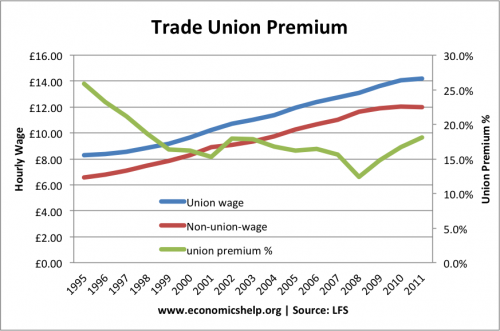- Definition – Collective bargaining refers to the negotiations between a group of workers and firms. Workers, usually through a trade union, form a unified approach to negotiate wages and work conditions with their firm (or group of firms).
- Collective bargaining can involve many different aspects of work – including pay, health and safety, working hours, pensions, training, disciplinary procedures and work disputes.
- Collective bargaining can be between a union and an individual firm, but it can also be across an industry with firms forming their own collective to negotiate wages with trade unions.
Advantages of collective bargaining
- Workers may not be comfortable in demanding higher wages or better working conditions with their employer. Collective bargaining enables the difficult task to be outsourced to someone who can concentrate on the job and not let it interfere with their job.
- Individual bargaining would be inefficient in terms of time and effort for both the firm and the worker. Collective bargaining enables wage settlements to be reached for the whole industry and firm.
- Counteract a monopsonist employer. A monopsonist employer has market power in employing workers. Therefore, the employer can pay wages below the equilibrium and employ fewer workers to maximise profits. Some form of collective bargaining can give workers sufficient negotiating power that they can push wages closer to the equilibrium – raising wages without adverse effects on employment.
- Counteraction to falling real wages. Since 2008 crisis, many countries saw employment growth but real wages remained quite low. The OECD has argued that collective bargaining can be an important tool to get real wage growth (at the moment only 33% of jobs in the OECD are covered by collective bargaining agreements.
“Collective bargaining. Read that chapter in the report! When the social partners themselves negotiate collective wages within a system where there are efficient negotiating mechanisms, you might get better wage growth.” (OECD)
Disadvantages of collective bargaining
- From the perspective of the firm, collective bargaining could cause workers to have too much influence with the threat of strikes causing wages to be pushed too high. If the firm is not a monopsonist, these wage increases may be at the expense of lower employment so some workers (insiders) benefit from wage increases but those outside the trade union experience lower wages.

- One example from the UK suggests trade unions can benefit from a wage premium of around 20%. Other studies suggest the wage premium can be more modest around 5-10%
- In the 1970s, and 80s, industrial action by trades unions caused many hours of work and output lost to the economy.
- Collective bargaining can become confrontational leading to a decline in relations between workers and firms, leading to a loss of productivity. It was also a factor in the wage-push inflation of the 1970s
Different types of collective bargaining
Collective bargaining can take different forms depending on the aims and approaches of different parties.
- Distributive bargaining. In this form of bargaining, it is seen as a zero-sum game with limited resources to be distributed according to the strength of different parties. For example, if a firm’s profit increases by £10 million, the union may feel that workers wages should increase by £8 million.
- Productivity bargaining. In this situation, workers and firms may find a way to increase wages and profits. For example, introducing higher wages in return for new working conditions which increase productivity and hence profits. In this form of bargaining, there is more of a common goal and less of an adversarial approach.
- Concessionary bargaining. In this situation, workers may give up pay, in return for job security. For example, if the firm sees a slump in demand, workers may accept a temporary wage cut as a way to reduce a firm’s costs and keep their job.
- Composite bargaining. Where a mixture of issues related to workers is raised in negotiations.. Not just pay but also working conditions and wider political issues such as the impact on the environment, discrimination and
Stages of collective bargaining
- Preparation – Union representatives listen to members to see what is important to them. This enables the union and firm to come up with goals from the negotiation.
- Opening proposals. Unions and firms put forward their stated aims, highlighting how important different goals are, whether there are any red-lines and what can be negotiated.
- Trading. Where firms and unions enter real negotiations – agreeing to one target in return for letting go of another,
- Agreement. If both sides can agree on a package, the new pay and working conditions will be signed and come into effect. If there is no agreement, the union may resort to industrial action or go to arbitration.
Evaluation of collective bargaining
- It depends on the type of collective bargaining is it distributive and confrontational or do the sides see the need of working together?
- What percentage of the workforce is involved in the collective bargaining process?
- How replaceable are workers. For example, if workers try to increase wages, can firms replace with non-union staff or mechanisation?
Related

